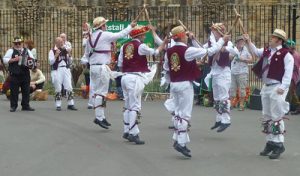
Britain’s many traditions and customs reflect the country’s rich cultural history. These celebrations are almost all tied to the agricultural calendar, local folklore, religious festivals, historical events, or communal identity. However, the relatively recent past has seen Britain undergo major technological advances, rapid urbanisation and mass immigration. These developments have fuelled a tremendous shift in Britain’s social norms. As a result, once well-supported customs and traditions are increasingly being forgotten.
Here’s a brief narrative on the old-age tradition of Morris dancing:
The Morris Dance
Morris dancing is a traditional English folk dance that is usually performed at historical festivals, special events, and other celebrations. The quirky dance consists of a series of choreographed, rhythmic steps. Dancers dress up in a special (usually white) uniform bearing sticks, swords, handkerchiefs, bells and other implements to perform. A small folk group or soloist typically accompanies the dancers. Similar styles of dance can be found throughout Europe, the Middle East, India, Central America and South America.

Photo credit: Flickr/CC BY 2.0
A Brief History
The English folk tradition of Morris dancing was first documented in 1448 though the custom is thought to be much older. The dance’s origins are uncertain but some think it has European or Moorish beginnings while others believe it is rooted in druidic traditions. Dancers often dressed in elaborate costumes to perform at masques and other court recitals. By the turn of the 17th century, Morris dancing had become synonymous with Whitsuntide and the working classes. In time, it became common to find Morris dancing being performed at numerous rural celebrations and festivals across the country.
After the dawn of the Industrial Revolution in the mid-18th century, rural areas began to depopulate as people moved to cities for work steadily. Thus, once-popular traditions like Morris dancing began to lose relevance and decline. As society saw new forms of entertainment emerge, Morris dancing’s downturn trend continued. This tendency continued until the turn of the 20th century when it saw a surprising upturn. The revival was mainly due to the efforts of a small group of enthusiasts who organised dance performances around London. In 1934, the Morris Ring was established which saw six clubs in the South of England being formed.
However, the resurgent movement was almost entirely in the hands of volunteers and amateur enthusiasts. Thus, unlike most other cultural art forms, Morris dancing received virtually no institutional support. The lack of financial backing and organised promotion was viewed as a hindrance to the movement’s development. The 1950s, and especially the 1960s, saw an upsurge in the interest of Morris when women were allowed to join teams for the first time (in the modern era).
Like many aspects of modern life, Morris dancing has faced a marked decline in recent years in tandem with the loss of rural traditions. However, it does have a continued loyal following from enthusiasts of rural pursuits and customs.





